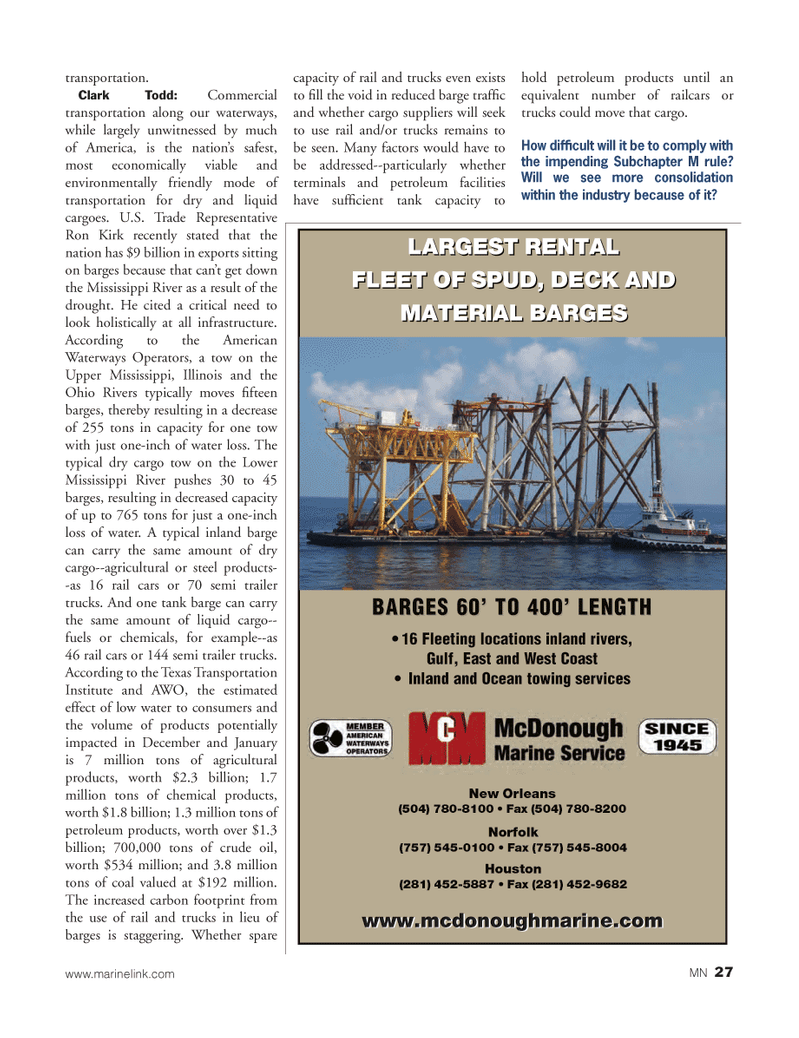
Page 27: of Marine News Magazine (February 2013)
Bulk Transport Leadership Roundtable
Read this page in Pdf, Flash or Html5 edition of February 2013 Marine News Magazine
transportation. Clark Todd: Commercial transportation along our waterways, while largely unwitnessed by much of America, is the nation?s safest, most economically viable and environmentally friendly mode of transportation for dry and liquid cargoes. U.S. Trade Representative Ron Kirk recently stated that the nation has $9 billion in exports sitting on barges because that can?t get down the Mississippi River as a result of the drought. He cited a critical need to look holistically at all infrastructure. According to the American Waterways Operators, a tow on the Upper Mississippi, Illinois and the Ohio Rivers typically moves fteen barges, thereby resulting in a decrease of 255 tons in capacity for one tow with just one-inch of water loss. The typical dry cargo tow on the Lower Mississippi River pushes 30 to 45 barges, resulting in decreased capacity of up to 765 tons for just a one-inch loss of water. A typical inland barge can carry the same amount of dry cargo--agricultural or steel products- -as 16 rail cars or 70 semi trailer trucks. And one tank barge can carry the same amount of liquid cargo-- fuels or chemicals, for example--as 46 rail cars or 144 semi trailer trucks. According to the Texas Transportation Institute and AWO, the estimated effect of low water to consumers and the volume of products potentially impacted in December and January is 7 million tons of agricultural products, worth $2.3 billion; 1.7 million tons of chemical products, worth $1.8 billion; 1.3 million tons of petroleum products, worth over $1.3 billion; 700,000 tons of crude oil, worth $534 million; and 3.8 million tons of coal valued at $192 million. The increased carbon footprint from the use of rail and trucks in lieu of barges is staggering. Whether spare capacity of rail and trucks even exists to ll the void in reduced barge traf c and whether cargo suppliers will seek to use rail and/or trucks remains to be seen. Many factors would have to be addressed--particularly whether terminals and petroleum facilities have suf cient tank capacity to hold petroleum products until an equivalent number of railcars or trucks could move that cargo. How difÞ cult will it be to comply with the impending Subchapter M rule? Will we see more consolidation within the industry because of it?New Orleans(504) 780-8100 ? Fax (504) 780-8200Norfolk(757) 545-0100 ? Fax (757) 545-8004Houston(281) 452-5887 ? Fax (281) 452-9682www.mcdonoughmarine.comwww.mcdonoughmarine.comLARGEST RENTAL FLEET OF SPUD, DECK AND MATERIAL BARGESBARGES 60 TO 400 LENGTHBARGES 60 TO 400 LENGTH? 16 Fleeting locations inland rivers, Gulf, East and West Coast ? Inland and Ocean towing services LARGEST RENTAL FLEET OF SPUD, DECK AND MATERIAL BARGESwww.marinelink.com MN 27MN Feb2013 Layout 18-31.indd 27MN Feb2013 Layout 18-31.indd 271/30/2013 4:49:31 PM1/30/2013 4:49:31 PM

 26
26

 28
28
